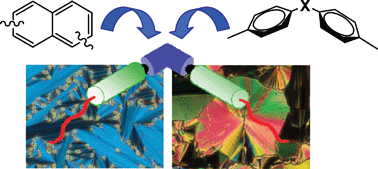Two series of bent-shaped molecules have been synthesized and their supramolecular self-organization at variable temperature has been studied. The majority of these bent-compounds form liquid crystalline phases and the mesomorphic behaviour of them has been fully characterized by polarised optical microscopy, calorimetry, X-ray diffraction and dielectric techniques. A series of bis-4-n-tetradecyloxybenzoyloxybenzoates derived from naphthalene, resulting in a change of the bending angle, have proved that when these cores bend around 120°, a polar lamellar packing (SmCaPA) can be induced, whereas when the angle was around 60°, an orthogonal lamellar arrangement (SmA) that responded to an electric field, are found to occur. Liquid-crystal order can also be achieved over a significant range of temperatures by using appropriate bis-4,4′-disubstituted phenylene derivatives (–Ar–X–Ar–). Groups such as –CO–, SO– and –CH2– connecting the aromatic rings induce the SmCaPA phase while a sulfide group (–S–) leads to columnar order. Further, the formation of isotropic textures as chiral conglomerates or a field-induced phase transition have also been observed as unusual properties of the self-organizations of these compounds.

You have access to this article
 Please wait while we load your content...
Something went wrong. Try again?
Please wait while we load your content...
Something went wrong. Try again?


 Please wait while we load your content...
Please wait while we load your content...